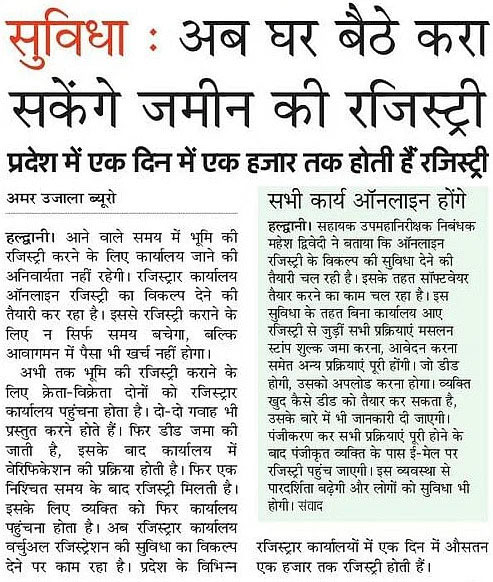Property registration is the legal process of recording and documenting the ownership or transfer of rights in a property with the relevant government authority or land registry. This process is necessary for proving and confirming legal ownership of real estate and provides a public record of property transactions. Property registration is an essential step in real estate transactions and is designed to protect the interests of both buyers and sellers. It establishes the identity of the owner and the property's boundaries. To ensure that the seller has a clear and marketable title to the property, the government agency inspects the chain of ownership throughout the registration process.
Process of Property Registration in Uttarakhand
Here's a more detailed breakdown of the property registration process:
- Verify Property Title and Documents: Make sure all property records are in order, including the sale deed, records of previous ownership, receipts for property taxes, and any other relevant documents.
- Property Valuation: To ascertain the property's market value, an authorized valuer may need to evaluate it. Stamp duty and registration fees are calculated using this valuation.
- Payment of Stamp Duty: Calculate and pay the applicable stamp duty. Stamp duty rates vary based on the property's value and location. This fee is typically paid to the state government.
- Obtain Non-Encumbrance Certificate: Obtain a non-encumbrance certificate from the sub-registrar's office. This certificate confirms that the property is free from any legal dues or pending mortgages.
- Draft Sale Deed: Prepare a sale deed and it should include all the relevant details about the property, such as the buyer's and seller's information, property description, sale price, and any other relevant terms.
- Visit the Sub-Registrar Office: Both the buyer and seller (or their authorized representatives) should visit the sub-registrar office in the property's jurisdiction. Two witnesses must also be present.
- Payment of Registration Fees: Pay the registration fees, which are usually a percentage of the property's value.
- Document Submission: Submit the sale deed and supporting documents to the sub-registrar. The sub-registrar will verify the documents and the information provided.
- Verification and Stamp Impression: After veryfying the documents, both the buyer and the seller (or their representatives) will sign the sale deed in the presence of two witnesses. After that, the sale deed gets the official stamp.
- Registration Certificate: After successful registration, the sub-registrar will issue a registration certificate. This certificate is proof of ownership and should be retained securely.
- Updating Property Records: After registration, update property records with local municipal authorities. This ensures you receive tax bills and other notices correctly.
- Mutation of Property: Apply for the mutation of property in the local municipal records to officially transfer the property title into your name.
- Encumbrance Certificate: Getting an encumbrance certificate from the sub-registrar's office is highly recommended. This certificate shows that the property is free from any pending legal disputes.
Documents Required for Property Registration
- Sale Deed: This is the primary document that establishes the ownership of the property. It includes details of the current owner, previous ownership history, property description, and transaction details. The sale deed should be executed on non-judicial stamp paper.
- Encumbrance Certificate: This certificate is a record of all transactions registered against the property for a specific period. I confirms that the property is free from any legal dues or pending mortgages.
- Property Tax Receipts: Proof of payment of property taxes up to the date of registration is often required.
- Khata Certificate: Khata certificate, which is a property account certificate, may be needed to verify that the property is listed with the local municipal authority.
- Identity and Address Proof: Both the buyer and the seller need to provide government-issued identity and address proofs, such as Aadhar card, passport, voter ID, or driver's license.
- PAN Card: Permanent Account Number (PAN) cards of both the buyer and seller are often required.
- Passport-size Photographs: Recent passport-sized photographs of the parties involved in the transaction, including the buyer, seller, and witnesses.
- No Objection Certificate (NOC): In some cases, an NOC may be required from the relevant authority, especially for agricultural land or properties in certain zones.
- Proof of Payment of Stamp Duty: Evidence of payment of stamp duty, which is a tax on property transactions, is essential for property registration.
- Agreement to Sell or Sale Agreement: This is a preliminary agreement between the buyer and seller outlining the terms and conditions of the property sale. A copy of this agreement may be required for registration.
- Bank NOC (if applicable): If the property is mortgaged or financed by a bank, a No Objection Certificate from the bank may be required.
- Affidavit and Undertaking: Sometimes, parties may be required to submit affidavits or undertakings stating certain facts or declarations related to the property or the transaction.
Benefit of Property Registration
Registering property is necessary for several important reasons, as it serves various legal, financial, and social purposes:
- Establishing Legal Ownership: Property registration is the primary means of legally establishing ownership of a property. It provides concrete proof that a person or entity is the rightful owner of the property.
- Preventing Property Disputes: Registration helps avoid legal problems and ownership disputes. It provides a transparent and publicly accessible record of property ownership, reducing the chances of multiple claims or fraudulent transactions.
- Protecting Property Rights: For the protection of property rights, the registration of real estate is essential. It guarantees that the owner's rights to use, sell, lease, or mortgage the property are legally accepted.
- Transferring Property: If a property is sold, gifted, or inherited, registration is necessary to transfer ownership to the new owner. Without proper registration, the transfer may not be legally recognized.
- Taxation: Property registration is linked to the payment of various property-related taxes, such as property tax, stamp duty, and registration fees. Accurate property registration helps local governments collect revenue, which is used for public services and infrastructure development.
- Evidence in Legal Proceedings: Registered property documents serve as crucial evidence in legal proceedings related to property disputes, inheritances, or other matters. They are often considered primary evidence in court.
- Preventing Fraud: Property fraud, such as illegal sales and fraudulent transfers, can be avoided through property registration.
- Securing Financing: When seeking a mortgage or loan using the property as collateral, lenders typically require proof of property registration. It gives them confidence in the property's legal status and the borrower's ownership rights, making it easier to secure financing.

